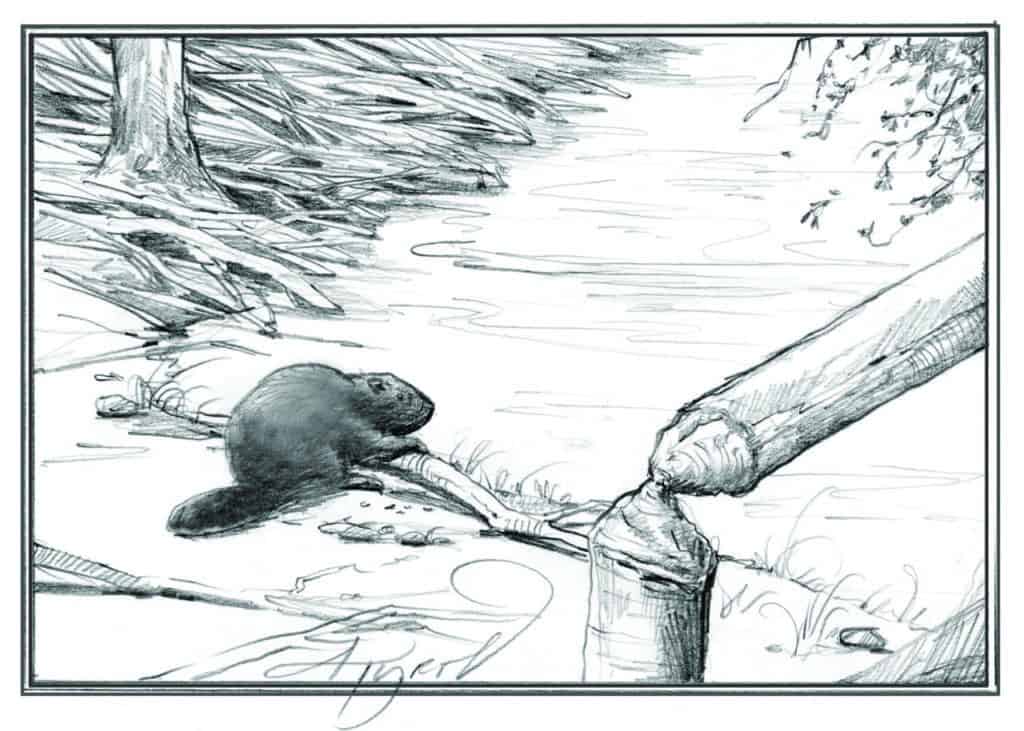
By Declan McCabe
When my sisters visit from Ireland, I try to play tour guide, but I’m occasionally at a loss for what to do next. During a visit in the late 1990s, my sister Grace said she would love to see a beaver. At that time, I lived close to a beaver pond and often quietly waited for beaver sightings. Alas, the rodents failed to cooperate for Grace’s visit, although she was able to see their engineering work. I was disappointed for her, but not surprised. Many of my own encounters ended with at most a fleeting glimpse, and a loud slap of a leathery tail on water.
When I returned to the pond years later, the beavers had departed — but the dam remained. Seven feet tall and made of sticks and mud, the dam had an upstream arch that spanned more than 50 feet of stream valley. According to Tom Wessels in his book “Reading the Forested Landscape,” old beaver dams can last for decades. Wessels points out that beavers engineer more than mere dams, however.
“Beavers are the only animals, other than humans, who will create entirely new ecosystems for their own use,” he writes. “And often, like humans, once they have depleted an area’s resources, they will abandon their holdings and move on.”
Beyond dams and lodges, beavers sometimes dig canals to aid their movement, as well as to float saplings and limbs to stock their underwater larders. Some tree species die after being drowned in beaver-made ponds, becoming habitat for woodpeckers and other wildlife. Some favored food trees, such as big-toothed aspen, resprout from their stumps, producing early successional habitat and multiple delectable stems for beavers to eat. Eventually, when the beavers exhaust their supply of food trees within easy distance from their pond, they seek out new wetlands. In their wake, they leave an enriched ecosystem that benefits other wildlife.
In areas where beavers can resettle along the same water system, their ponds can serve as aquatic habitats for decades. Well established beaver populations provide a complex combination of active ponds, abandoned ponds, and beaver meadows in various phases of succession. These create a diverse set of habitats that increases biological diversity across the landscape.
Abandoned beaver ponds accumulate silt and fallen leaves, forming rich soil that eventually fills the pond basin. Light from the canopy gap and well-watered, rich soils support lush communities of grasses and wildflowers called “beaver meadows,” which store an abundance of carbon. This soil continues to build as grasses grow, live, and die. Beaver meadows may remain open for decades, even if the beavers don’t re-flood the area, due in part to a lack of mycorrhizae necessary for tree colonization.
Another important physical impact on the landscape is the animals’ effect on groundwater. Beaver ponds are far deeper than undammed streams, and pond water saturates surrounding soils. This raises the groundwater table for some distance around the pond. The pond, together with the higher water table, stores a huge volume of water. During dry spells, water seeps from the pond and riparian water table to sustain streamflow. Rainstorms that might otherwise have quickly scoured and eroded streambanks recharge the pond and water table. Flooding from small storms is contained by the combined water storage capacity, and erosion caused by larger storms is reduced.
I was surprised to learn that beavers also live in — and engineer — salt marshes. In his studies of beavers in Washington state, researcher Gregory Hood found the animals constructing dams in tidal marshes that were submerged completely during high tide but retained water as the tide went out. These dammed marshes provided far more habitat for juvenile fish than similar marshes lacking beaver dams. Beavers sometimes pay a high price for their marine existence, however. In a 2019 article, Ben Goldfarb (author of the popular book about beavers, “Eager”) described beavers suffering and dying from salt intoxication after consuming too much sea water.
Although my sister and I didn’t see beavers during our rambles in Vermont, Grace may now have some hope for beaver sightings closer to home. In Scotland, the reintroduction of beavers in 2009 has resulted in an increase in lake levels, higher retention of organic matter in streams, and reduced flooding. In 2016 the Scottish government deemed the reintroduction a success, and in 2019 declared beavers a protected species. It seems Scottish beavers are having positive impacts, much like their North American cousins.
Declan McCabe teaches biology at Saint Michael’s College. His book, “Turning Stones: Exploring Life in Freshwater,” will be published this spring by McDonald & Woodward. Illustration by Adelaide Murphy Tyrol. The Outside Story is assigned and edited by Northern Woodlands magazine and sponsored by the Wellborn Ecology Fund of the New Hampshire Charitable Foundation: nhcf.org.




